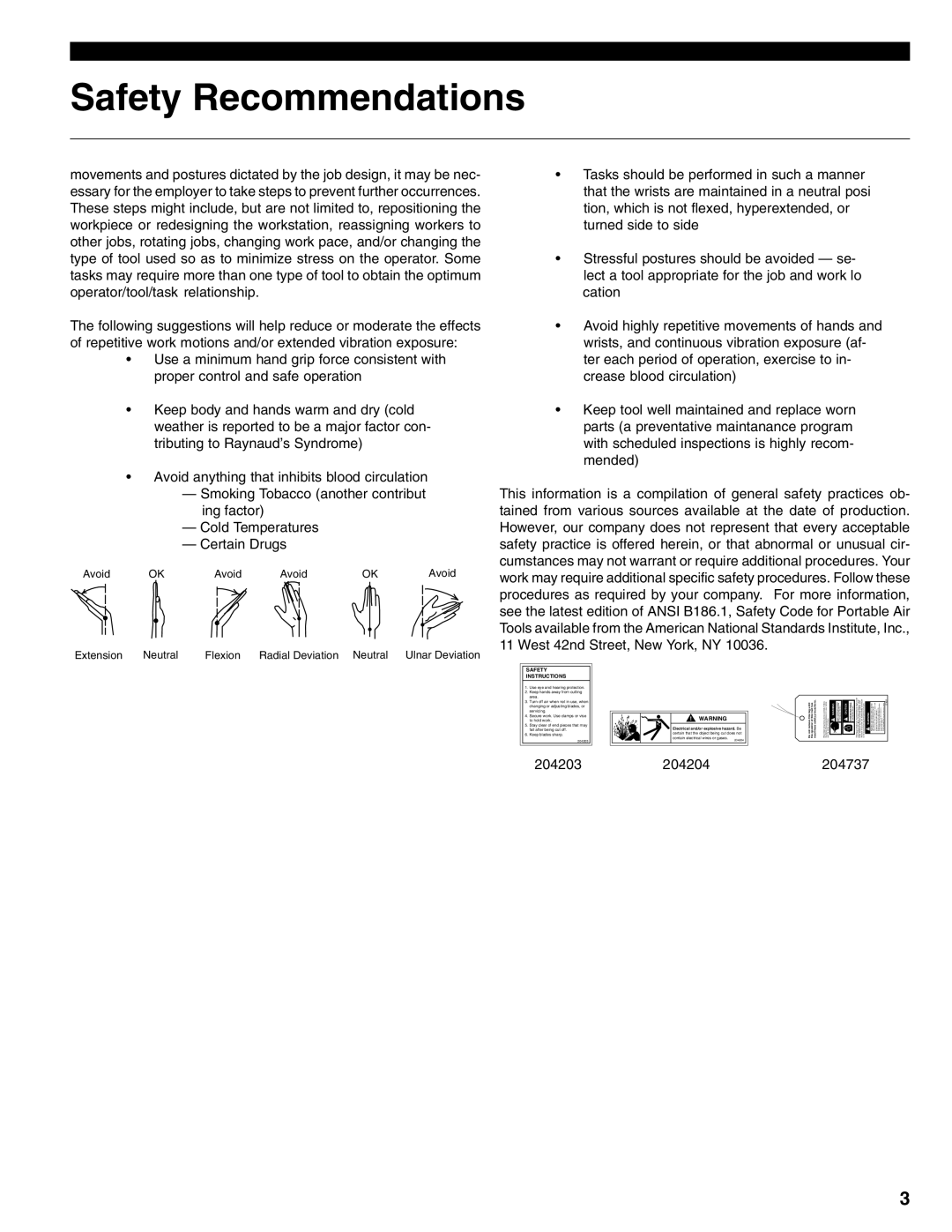
Safety Recommendations
movements and postures dictated by the job design, it may be nec- essary for the employer to take steps to prevent further occurrences. These steps might include, but are not limited to, repositioning the workpiece or redesigning the workstation, reassigning workers to other jobs, rotating jobs, changing work pace, and/or changing the type of tool used so as to minimize stress on the operator. Some tasks may require more than one type of tool to obtain the optimum operator/tool/task relationship.
The following suggestions will help reduce or moderate the effects of repetitive work motions and/or extended vibration exposure:
•Use a minimum hand grip force consistent with proper control and safe operation
•Keep body and hands warm and dry (cold weather is reported to be a major factor con- tributing to Raynaud’s Syndrome)
•Avoid anything that inhibits blood circulation
—Smoking Tobacco (another contribut ing factor)
—Cold Temperatures
—Certain Drugs
Avoid | OK | Avoid | Avoid | OK | Avoid |
Extension | Neutral | Flexion | Radial Deviation Neutral | Ulnar Deviation |
•Tasks should be performed in such a manner that the wrists are maintained in a neutral posi tion, which is not flexed, hyperextended, or turned side to side
•Stressful postures should be avoided — se- lect a tool appropriate for the job and work lo cation
•Avoid highly repetitive movements of hands and wrists, and continuous vibration exposure (af- ter each period of operation, exercise to in- crease blood circulation)
•Keep tool well maintained and replace worn parts (a preventative maintanance program with scheduled inspections is highly recom- mended)
This information is a compilation of general safety practices ob- tained from various sources available at the date of production. However, our company does not represent that every acceptable safety practice is offered herein, or that abnormal or unusual cir- cumstances may not warrant or require additional procedures. Your work may require additional specific safety procedures. Follow these procedures as required by your company. For more information, see the latest edition of ANSI B186.1, Safety Code for Portable Air Tools available from the American National Standards Institute, Inc., 11 West 42nd Street, New York, NY 10036.
SAFETY
INSTRUCTIONS
1.Use eye and hearing protection.
2.Keep hands away from cutting
6. | area. |
|
| thisremovenotDo tag until thisofoperatorthe tool has safetythesereadprecautions. | InstructionsOperatingReadcarefully. Follow RecommendationsSafetythe for your safety others.ofsafetytheand | ! WARNING | ! CAUTION | recommendedisprotectionHearing in high noise Close.dBA)85(aboveareasproximity of other surfaces,reflectivetools,process noises, and substantiallycanstructuresresonant contribute experiencedlevelsoundtheto by the user. WARNING! | OVER |
Keep blades sharp. |
|
| |||||||
3. | Turn off air when not in use, when |
|
|
|
|
|
|
|
|
| changing or adjusting blades, or |
|
|
|
|
|
|
|
|
| servicing. |
|
|
|
|
|
|
|
|
4. | Secure work. Use clamps or vise | ! | WARNING |
|
|
|
|
|
|
| to hold work. |
|
|
|
|
|
| ||
5. | Stay clear of end pieces that may | Electrical and/or explosive hazard. Be |
|
|
|
|
|
| |
| fall after being cut off. |
|
|
|
|
|
| ||
|
| certain that the object being cut does not |
|
|
|
|
|
| |
|
| contain electrical wires or gases. |
|
|
|
|
|
| |
| 204203 |
| 204204 |
|
|
|
|
|
|
| 204203 | 204204 |
| 204737 |
| ||||
3
